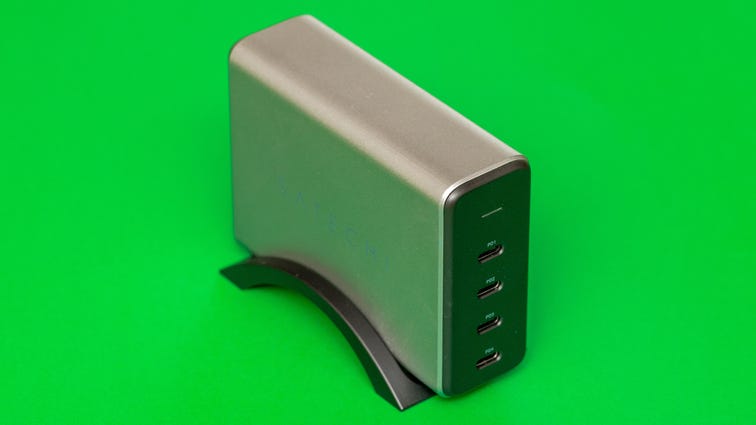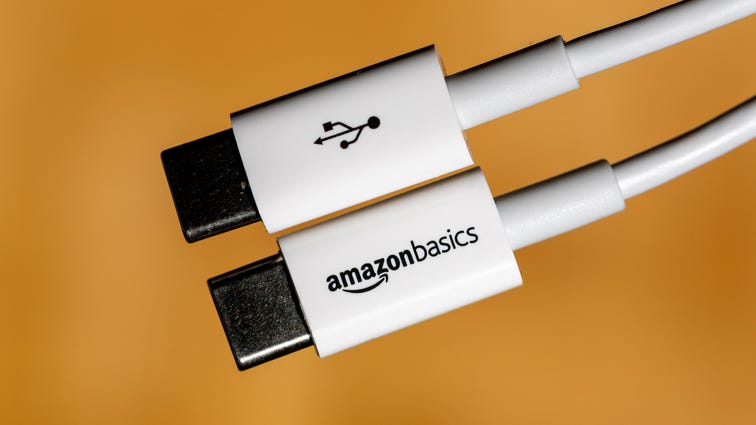Best USB-C Chargers, Docks, Batteries and Other Accessories
[ad_1]
After some growing pains, USB-C has hit its stride. Many laptops and phones come with USB-C ports for data and charging, and now an abundance of accessories take advantage of the standard.
Even Apple, which for years favored its competing Lightning connector, is building USB-C into new iPads and reportedly will release USB-C iPhones in 2023. That’s great, because more USB-C devices means more USB-C charging ports everywhere, so you’re less likely to be stuck with a drained battery in an airport, office or friend’s car.
Accessories unlock USB-C’s potential. USB docks and hubs multiply the abilities of a single USB-C port on your laptop. Multiport chargers are great for people with lots of devices to charge, and efficient new gallium nitride, aka GaN, electronics makes them smaller and lighter. And now USB-C is increasingly useful as a video port to connect external monitors.
We’ve tested a range of products to help you get the most out of USB-C. This is a general list, but you can also check out our picks for best USB-C chargers and best USB-C hubs and docking stations.
First, though, a little explanation, because USB standards can be confusing. USB-C is the physical connection. It’s the oval port and the reversible cables that now are commonplace on laptops and Android phones. The main USB standard is currently at USB 4.0. This governs the data connections between devices, for example plugging a backup drive into your PC. USB Power Delivery (USB PD) governs how devices cooperate for charging and is newly upgraded to reach powerful 240-watt levels.
USB-C is good for replacing both the original rectangular USB-A ports that first arrived on 1990s PCs to connect printers and mice. The small, trapezoidal ports that caught on for phone charging are called USB Micro B.
Stephen Shankland/CNET
This little two-port GaN unit is so much better than conventional phone chargers that it stopped me from being grouchy that phone makers stopped including them. Anker’s Nano Pro 521 is just a little bigger but capable of pumping juice at 37 watts — enough that I use it to power my laptop most days. That’s not as much power as bigger laptop chargers offer, but it’s super small and enough for my daily needs. You can toss into your backpack before heading to school or work.
Stephen Shankland/CNET
If you’re moving into the USB-C future, this charger is great. It dispenses entirely with the legacy USB-A ports while offering lots of power over its four ports. It uses GaN charging technology, which lets designers shrink chargers into compact sizes unthinkably small compared to a few years ago. This one delivers 165 watts total. Its included power cable can be handy but bulks up the package if you’re traveling.
Stephen Shankland/CNET
Thanks to GaN power electronics, this little number from Hyper packs a wallop: 100 watts of charging from three USB-C ports and one USB-A port. Its power prongs flip out of the way for more compact stowing, making it great for travel. Even better, it’s got a power plug on the side that lets you plug in something else or stack another of Hyper’s chargers right on top.
Josh Goldman/CNET
This reasonably priced hub adds a lot of utility to a single port on your laptop. It’s got three USB-A ports, microSD and SD card slots, a gigabit Ethernet jack with helpful and unusual activity LEDs, and an HDMI port that supports 4K video at 30Hz. Labels on top of the anodized aluminum case help you figure out what cable goes where a little bit faster. Its USB-C port can pass along 100 watts of power from an external charger or connect to a peripheral at 5Gbps.
Stephen Shankland/CNET
The Fledgling Spruce is fine for your desk, but great for kitchen countertops where people are coming and going and just need a quick charge. Three USB-C ports are good for phones, tablets and laptops if you’re OK with modest charging speeds. On top is a Qi wireless charger, good for iPhones and Android phones, that flips up into a convenient stand. A single USB-A port is useful for AirPods or older iPhones. In short, it’s a good multipurpose station where people can drop off their phones during breakfast or dinner. It’s compact, with GaN technology, but don’t expect top charging rates if you’re using all the ports.
Stephen Shankland/CNET
Finally, USB-C has evolved beyond initial limitations that meant hubs only had one port. With four USB-C and three USB-A ports, this is the hub for you if you need to plug in lots of peripherals such as thumb drives or external drives. All the ports can charge phones or tablets, though you’ll need to plug a charger into one of its USB-C ports if you need higher power levels. The hub’s USB-C ports can’t handle monitors, unfortunately.
Stephen Shankland/CNET
This 26,800-mAh battery pack is just what you need to keep your laptop running when out and about, whether photographers on a shoot or businesspeople on long airplane flights. It’s got four USB-C ports, two rated at 100 watts for laptops and two lower-power ports good for phones. An OLED status display is useful for tracking usage and remaining battery life, all in a rugged aluminum housing.
Stephen Shankland/CNET
The combination of USB-C and GaN has been a godsend for car charging. This compact Anker charger has two relatively high power USB-C ports, enough to deliver 27 watts to my laptop. That’s enough for moderately fast charging. If you have an iPhone, make sure you get a USB-C-to-Lightning cable.
Stephen Shankland/CNET
This clever design snaps into the two USB-C/Thunderbolt ports on the side of a MacBook. A narrow shim ensures a snug fit, although you can skip it and use the included short cable to plug into any USB-C port if you’re away from your MacBook. In addition to 5Gbps USB-A and USB-C ports, it’s got a full-on Thunderbolt/USB-C port that reaches 40Gbps, a pop-up Ethernet jack, an SD Card slot, an HDMI port and a 3.5mm audio jack.
Stephen Shankland/CNET
If your laptop’s solid-state drive is running out of space, this hub has a compartment for M.2 SSDs for conveniently boosting storage space. It’s also got a pass-through USB-C charging port, two USB-A ports and an HDMI video port. The SSD isn’t included.
Stephen Shankland/CNET
If you need to plug three 4K monitors into your computer — and some people do, for tasks like programming, monitoring finances and designing buildings — the VisionTek VT7000 will let you do that from a single USB-C port. It’s also got an Ethernet jack, a 3.5mm audio jack, and two USB-C and two USB-A ports for other peripherals. The cable to your laptop delivers power up to a healthy 100 watts with the included cable, making this a very versatile docking station. One of the monitor ports is HDMI only, but the other two let you plug in either HDMI or DisplayPort cables. Note that it comes with a beefy power adapter, and you have to install drivers for Synaptics’ DisplayLink technology to support all those monitors.
Stephen Shankland/CNET
Long USB-C charging cables are common, but they’re usually just rated for slow data transfer speeds. Plugable offers the best of both worlds with its 6.6-foot (2 meter) USB-C cable. It’s rated for 40Gbps data transfer — enough for dual 4K monitors — and 100 watts of power delivery. You’ll pay a premium for those features at this length, but sometimes a 1-meter cable doesn’t reach where you need it to. It’s also certified for Intel’s Thunderbolt connection technology, on which newer USB data-transfer standards employ.
Stephen Shankland/CNET
I had fraying problems with Satechi’s earlier cables, but they’ve beefed up the braided housing and connectors for their newer models. They look classy, feel supple, include a tie to tidy up the coils and are rated for 40Gbps data transfer and 100 watts of power.
Stephen Shankland/CNET
Amazon’s cheap but sturdy cable gets the job done. It’s not as supple or durable as higher-end options, and it only supports USB 2’s slow, archaic 480Mbps data transfer speeds, but you might not always want to pay a premium if you’re just charging your Nintendo Switch controllers.
Stephen Shankland/CNET
What can I say? This 6-foot braided cable is affordable and looks great in red. My test models worked reliably, charging iPhones for months over lots of car trips and office use. You can save a couple bucks if you only need 3 feet, but 6 feet is nice for reaching the outlet when you’re lying in bed scrolling through TikTok until 1 a.m.
Stephen Shankland/CNET
A bit bigger than a 9-volt battery, the Chargerito is the smallest USB-C charger I’ve found. It even comes with a keychain loop. It plugs into the wall with flip-out power prongs and another flip-out USB-C connector, so you don’t need a cord. It’s sturdy enough, but don’t put it in the hallway where you or your dog might bang into it.
Stephen Shankland/CNET
I like this compact Baseus charger for its two USB-C and two USB-A ports, but what helps set it apart from others is a pair of regular grounded outlets that you can use for more chargers or other devices. That’s really useful for families traveling, where you might not have enough power outlets, or for gadget-heavy excursions. Its USB-C ports delivered a healthy 61 watts to my laptop in my charging tests. Its built-in power cord is pretty beefy, so it’s not as small as a charger with flip-out power prongs, despite its compact GaN power electronics. In my view, though, the power cord length is often very useful. Another perk: It comes with a USB-C charging cable.
Stephen Shankland/CNET
This hulking 512-Wh battery has a single USB-C port, three USB-A ports and four conventional power outlets. I’d rather have more USB-C ports and fewer USB-A, but this is still really useful, with plenty of capacity to top up multiple devices. It’s a good idea for emergency power outages or working on the road, especially if you’re charging drone batteries or draining your phone battery using it as a Wi-Fi hot spot.
The USB-C port maxed out at a healthy 56-watt rate. But plugging my Mac power adapter into its power plug let me reach 90 watts — an approach I’d use sparingly since it wastes energy converting power from DC to AC and back. A front status panel lets you monitor its capacity, and a carrying handle makes it more portable. It’s also got a handy built-in lighting bar.
To ensure the Power Station doesn’t drain while not in use, be sure to switch on power-saving mode. And turn that off to keep the system awake for intermittent jobs taking time-lapse photos or running CPAP medical equipment. I found it handy to power a digital telescope. If you’re car camping, you can charge it from your car’s 12-volt port.
USB-C FAQs
The USB-C standard emerged in 2015 to fix a variety of problems that cropped up as USB expanded past plugging in printers to becoming an all-purpose charging and data port. First, it’s a smaller connector than the older rectangular USB-A port, which means it fits on phones, tablets and other small devices. Second, it’s reversible, which means there’s no fiddling to make sure the connector is right side up. Third, it’s got a built-in “alt mode” that can extend a USB-C port’s abilities so it can handle HDMI and DisplayPort video or Intel’s Thunderbolt data and charging connections.
What are the pitfalls of USB-C?
The versatility of USB-C has brought some problems, because not all laptops, phones, cables and accessories support all possible USB-C abilities. Unfortunately, that means you often have to read the fine print to ensure USB-C can do what you need. It’s very common for USB-C charging cables to communicate only with slow USB 2 data-transfer speeds, and fast USB 3 or USB 4 cables are shorter and more expensive. Not all USB hubs can handle video signals, too. Last, check that USB-C cables can handle the power you need. Higher-end laptops can draw 100 watts of power, a top rating for USB-C cables, but USB-C is being expanded with 240-watt charging abilities for gaming laptops and other power-hungry devices.
[ad_2]
Source link
























